How Much Does Weather Matter? Effects of Rain and Wind on PM Accumulation by Four Species of Australian Native Trees
Abstract
:1. Introduction
2. Methods
2.1. Study Area and Plant Material
2.2. Sample Collection
2.3. Quantitative Analysis of PM and Leaf Waxes
2.4. Measurement of PM Concentration in Air and Ambient Weather Conditions
2.5. Statistical Analysis
3. Results
3.1. Particulate Matter Accumulation
3.1.1. General PM Accumulation and Amount of Waxes
3.1.2. Accumulation of Different PM Fractions during the Sampling Period
3.1.3. Accumulation of SPM and WPM during Time Period
3.2. Amount of PM in Air and Weather Conditions during the Study Period
3.3. Correlation Analysis
4. Discussion
5. Conclusions
Author Contributions
Funding
Acknowledgments
Conflicts of Interest
References
- World Health Organization. Ambient Air Pollution: A Global Assessment of Exposure and Burden of Disease; WHO Press: Geneva, Switzerland, 2016. [Google Scholar]
- Bell, M.L.; Morgenstern, R.D.; Harrington, W. Quantifying the human health benefits of air pollution policies: Review of recent studies and new directions in accountability research. Environ. Sci. Policy 2011, 14, 357–368. [Google Scholar] [CrossRef]
- Farmer, A. Effects of particulates. In Air Pollution and Plant Life, 2nd ed.; Bell, J.N.B., Treshow, M., Eds.; John Wiley & Sons: Hoboken, NJ, USA, 2002; pp. 187–199. [Google Scholar]
- Lin, J.; Pan, D.; Davis, S.J.; Zhang, Q.; He, K.; Wang, C.; Streets, D.G.; Wuebbles, D.J.; Guan, D. China’s international trade and air pollution in the United States. Proc. Natl. Acad. Sci. USA 2014, 111, 1736–1741. [Google Scholar] [CrossRef] [PubMed]
- Beckett, K.P.; Freer-Smith, P.; Taylor, G. Urban woodlands: Their role in reducing the effects of particulate pollution. Environ. Pollut. 1998, 99, 347–360. [Google Scholar] [CrossRef]
- Bosko, M.L.; Varrica, D.; Dongorrá, G. Case study: Inorganic pollutants associated with particulate matter from an area near a petrochemical plant. Environ. Res. 2005, 99, 18. [Google Scholar] [CrossRef]
- Suzuki, K. Characterisation of airborne particulates and associated trace metals deposited on tree bark by ICP-OES, ICP-MS, SEM–EDX and laser ablation ICP-MS. Atmos. Environ. 2006, 40, 2626–2634. [Google Scholar] [CrossRef]
- Gunawardena, J.; Egodawatta, P.; Ayoko, G.A.; Goonetilleke, A. Role of traffic in atmospheric accumulation of heavy metals and polycyclic aromatic hydrocarbons. Atmos. Environ. 2012, 54, 502–510. [Google Scholar] [CrossRef] [Green Version]
- Alghamdi, M.A. Characteristics and risk assessment of heavy metals in airborne PM10 from a residential area of northern Jeddah city, Saudi Arabia. Pol. J. Environ. Stud. 2016, 25, 939–949. [Google Scholar] [CrossRef]
- Chen, W.; Zheng, R.; Baade, P.D.; Zhang, S.; Zeng, H.; Bray, F.; Jemal, A.; Yu, X.Q.; He, J. Cancer statistics in China, 2015. C.A. Cancer J. Clin. 2016, 66, 115–132. [Google Scholar] [CrossRef] [Green Version]
- Xing, Y.F.; Xu, Y.H.; Shi, M.H.; Lian, Y.X. The impact of PM2.5 on the human respiratory system. J. Thorac. Dis. 2016, 8, E69–E74. [Google Scholar] [CrossRef]
- Silva, R.A.; West, J.J.; Zhang, Y.; Anenberg, S.C.; Lamarque, J.-F.; Shindell, D.T.; Collins, W.J.; Dalsoren, S.; Faluvegi, G.; Folberth, G.; et al. Global premature mortality due to anthropogenic outdoor air pollution and the contribution of past climate change. Environ. Res. Lett. 2013, 8, 034005. [Google Scholar] [CrossRef]
- Popek, R.; Łukowski, A.; Bates, C.; Oleksyn, J. Particulate matter, heavy metals and polycyclic aromatic hydrocarbons accumulation on the leaves of Tilia cordata Mill. in five Polish cities with different level of air pollution. Int. J. Phytoremediation 2017, 19, 1134–1141. [Google Scholar] [CrossRef] [PubMed]
- Li, Y.; Wang, S.; Chen, Q. Potential of thirteen urban greening plants to capture particulate matter on leaf surfaces across three levels of ambient atmospheric pollution. Int. J. Environ. Res. Public Health 2019, 16, 402. [Google Scholar] [CrossRef] [PubMed]
- Popek, R.; Gawrońska, H.; Gawroński, S.W. The level of particulate matter on foliage depends on the distance from the source of emission. Int. J. Phytoremediation 2015, 17, 1262–1268. [Google Scholar] [CrossRef] [PubMed]
- Janhäll, S. Review on urban vegetation and particle air pollution–deposition and dispersion. Atmos. Environ. 2015, 105, 130–137. [Google Scholar] [CrossRef]
- Pugh, T.A.M.; MacKenzie, R.A.; Whyatt, D.J.; Hewitt, N.C. Effectiveness of green infrastructure for improvement of air quality in urban street canyons. Environ. Sci. Technol. 2012, 46, 7692–7699. [Google Scholar] [CrossRef]
- Dzierżanowski, K.; Popek, R.; Gawrońska, H.; Sæbø, A.; Gawroński, S.W. Deposition of particulate matter of different size fractions on leaf surfaces and in waxes of urban forest species. Int. J. Phytoremediation 2011, 13, 1037–1046. [Google Scholar] [CrossRef] [PubMed]
- Chen, L.; Liu, C.; Zhang, L.; Zou, R.; Zhang, Z.Q. Variation in tree species ability to capture and retain airborne fine particulate matter (PM2.5). Sci. Rep. 2017, 7, 3206. [Google Scholar] [CrossRef]
- Nguyen, T.; Yu, X.; Zhang, Z.; Liu, M.; Liu, X. Relationship between types of urban forest and PM2.5 capture at three growth stages of leaves. J. Environ. Sci-China. 2015, 27, 33–41. [Google Scholar] [CrossRef]
- Liang, D.; Ma, C.; Wang, Y.; Wang, Y.; Chen, Z. Quantifying PM2.5 capture capability of greening trees based on leaf factors analyzing. Environ. Sci. Pollut. Res. 2016, 23, 21176–21186. [Google Scholar] [CrossRef]
- Zhang, W.; Wang, B.; Niu, X. Relationship between leaf surface characteristics and particle capturing capacities of different tree species in Beijing. Forests 2017, 8, 92. [Google Scholar] [CrossRef]
- Popek, R.; Łukowski, A.; Karolewski, P. Particulate matter accumulation – further differences between native Prunus padus and nonnative Prunus Serotina. Dendrobiology 2017, 78, 85–95. [Google Scholar] [CrossRef]
- Leonard, R.J.; McArthur, C.; Hochuli, D.F. Particulate matter deposition on roadside plants and the importance of leaf trait combinations. Urban For. Urban Green. 2016, 20, 249–253. [Google Scholar] [CrossRef]
- Sæbø, A.; Popek, R.; Nawrot, B.; Hanslin, H.M.; Gawronska, H.; Gawroński, S.W. Plant species differences in particulate matter accumulation on leaf surfaces. Sci. Total. Environ. 2012, 427–428, 347–354. [Google Scholar] [CrossRef]
- Popek, R.; Gawrońska, H.; Sæbø, A.; Wrochna, M.; Gawroński, S.W. Particulate matter on foliage of 13 woody species: Deposition on surfaces and phytostabilisation in waxes—A 3–year study. Int. J. Phytoremediation 2013, 15, 245–256. [Google Scholar] [CrossRef]
- Xu, Y.; Xu, W.; Mo, L.; Heal, M.R.; Xu, X.; Yu, X. Quantifying particulate matter accumulated on leaves by 17 species of urban trees in Beijing, China. Environ. Sci. Pollut. Res. 2018, 25, 12545–12556. [Google Scholar] [CrossRef] [Green Version]
- Zhang, B.; Jiao, L.M.; Xu, G.; Zhao, S.L.; Tang, X.; Zhou, Y.; Gong, C. Influences of wind and precipitation on different–sized particulate matter concentrations (PM2.5, PM10, PM2.5–10). Meteorol. Atmos. Phys. 2017, 3, 383–392. [Google Scholar] [CrossRef]
- Przybysz, A.; Sæbø, A.; Hanslin, H.M.; Gawroński, S.W. Accumulation of particulate matter and trace elements on vegetation as affected by pollution level, rainfall and the passage of time. Sci. Total Environ. 2014, 481, 360–369. [Google Scholar] [CrossRef]
- Wang, L.; Gong, H.L.; Liao, W.; Wang, Z. Accumulation of particles on the surface of leaves during leaf expansion. Sci. Total Environ. 2015, 532, 420–434. [Google Scholar] [CrossRef]
- Cai, M.; Xin, Z.; Yu, X. Spatio–temporal variations in PM leaf deposition: A meta–analysis. Environ. Pollut. 2017, 231, 207–218. [Google Scholar] [CrossRef]
- Weerakkody, U.; Dover, J.W.; Mitchell, P.; Reiling, K. Evaluating the impact of individual leaf traits on atmospheric particulate matter accumulation using natural and synthetic leaves. Urban For. Urban Green. 2018, 30, 98–107. [Google Scholar] [CrossRef]
- Wang, H.; Shi, H.; Wang, Y. Effects of weather, time, and pollution level on the amount of particulate matter deposited on leaves of Ligustrum lucidum. Sci. World J. 2015, 935942. [Google Scholar] [CrossRef]
- Xu, X.; Zhang, Z.; Bao, L.; Mo, L.; Yu, X.; Fan, D.; Lun, X. Influence of rainfall duration and intensity on particulate matter removal from plant leaves. Sci. Total Environ. 2017, 609, 11–16. [Google Scholar] [CrossRef] [PubMed]
- Schaubroeck, T.; Deckmyn, G.; Neirynck, J.; Staelens, J.; Adriaenssens, S.; Dewulf, J.; Muys, B.; Verheyen, K. Multilayered modeling of particulate matter removal by a growing forest over time, from plant surface deposition to washoff via rainfall. Environ. Sci. Technol. 2014, 48, 10785–10794. [Google Scholar] [CrossRef] [PubMed]
- Liu, L.; Guan, D.; Peart, M.R.; Wang, G.; Zhang, H.; Li, Z. The dust retention capacities of urban vegetation—A case study of Guangzhou, South China. Environ. Sci. Pollut. Res. Int. 2013, 20, 6601–6610. [Google Scholar] [CrossRef] [PubMed]
- Zhang, H.; Wang, Y.; Hu, J.; Ying, Q.; Hu, X.M. Relationships between meteorological parameters and criteria air pollutants in three megacities in China. Environ. Res. 2015, 140, 242–254. [Google Scholar] [CrossRef]
- Tian, G.; Qiao, Z.; Xu, X. Characteristics of particulate matter (PM10) and its relationship with meteorological factors during 2001–2012 in Beijing. Environ. Pollut. 2014, 192, 266–274. [Google Scholar] [CrossRef] [PubMed]
- Duhanyan, N.; Roustan, Y. Below-cloud scavenging by rain of atmospheric gases and particulates. Atmos. Environ. 2011, 45, 7201–7217. [Google Scholar] [CrossRef]
- Blanco–Becerra, L.C.; Gáfaro–Rojas, A.I.; Rojas–Roa, N.Y. Influence of precipitation scavenging on the PM2.5/PM10 ratio at the Kennedy locality of Bogotá, Colombia. Rev. fac. ing. univ. Antioquia 2015, 76, 58–62. [Google Scholar]
- Czernecki, B.; Półrolniczak, M.; Kolendowicz, L.; Marosz, M.; Kendzierski, S.; Pilguj, N. Influence of the atmospheric conditions on PM10 concentrations in Poznań, Poland. J. Atmos. Chem. 2017, 74, 115–139. [Google Scholar] [CrossRef]
- Google Maps. Available online: https://www.google.com/maps (accessed on 11 October 2019).
- NSW Roads & Maritime Services, Traffic Volume Viewer. Available online: https://www.rms.nsw.gov.au/about/corporate-publications/statistics/traffic-volumes/aadt-map/index.html (accessed on 11 October 2019).
- Australian Government Bureau of Meteorology. Available online: http://www.bom.gov.au (accessed on 1 March 2019).
- WHO Global Ambient Air Quality Database (update 2018). Available online: https://www.who.int/airpollution/data/cities/en/ (accessed on 16 March 2019).
- Mo, L.; Ma, Z.; Xu, Y.; Sun, F.; Lun, X.; Liu, X.; Chen, J.; Yu, X. Assessing the capacity of plant species to accumulate particulate matter in Beijing, China. PLoS ONE 2015, 10, e0140664. [Google Scholar] [CrossRef]
- Weerakkody, U.; Dover, J.W.; Mitchell, P.; Reiling, K. Quantification of the traffic–generated particulate matter capture by plant species in a living wall and evaluation of the important leaf characteristics. Sci. Tot. Environ. 2018, 635, 1012–1024. [Google Scholar] [CrossRef] [PubMed]
- Kupčinskienė, E.; Huttunen, S. Long–term evaluation of the needle surface wax condition of Pinus sylvestris around different industries in Lithuania. Environ. Pollut. 2005, 137, 610–618. [Google Scholar] [CrossRef] [PubMed]
- Pal, A.; Kulshreshtha, K.; Ahmad, K.J.; Behl, K.M. Do leaf surface characters play a role in plant resistance to auto-exhaust pollution? Flora Morphol. Distrib. Funct. Ecol. Plants 2002, 197, 47–55. [Google Scholar] [CrossRef]
- Beckett, K.P.; Freer Smith, P.H.; Taylor, G. Effective tree species for local air quality management. J. Arboric. 2000, 26, 12–19. [Google Scholar]
- Sgrigna, G.; Sæbø, A.; Gawronski, S.; Popek, R.; Calfapietra, C. Particulate Matter deposition on Quercus ilex leaves in an industrial city of central Italy. Environ. Pollut. 2015, 197, 187–194. [Google Scholar] [CrossRef] [PubMed]
- Gratani, L.; Crescente, M.F.; Petruzzi, M. Relationship between leaf life–span and photosynthetic activity of Quercus ilex in polluted urban areas (Rome). Environ. Pollut. 2000, 110, 19–28. [Google Scholar] [CrossRef]
- Hanslin, H.M.; Przybysz, A.; Slimestad, R.; Sæbø, A. Stress acclimation and particulate matter accumulation in Pinus sylvestris saplings affected by moderate combinations of urban stressors. Sci. Total Environ. 2017, 593–594, 581–591. [Google Scholar] [CrossRef]
- Gawroński, S.W.; Gawrońska, H.; Lomnicki, S.; Sӕbo, A.; Vangronsveld, J. Plants in air phytoremediation. Adv. Bot. Res. 2017, 83, 319–346. [Google Scholar] [CrossRef]
- Ali, H.; Khan, E.; Sajad, S.A. Phytoremediation of heavy metals—Concepts and applications. Chemosphere 2013, 91, 869–881. [Google Scholar] [CrossRef]
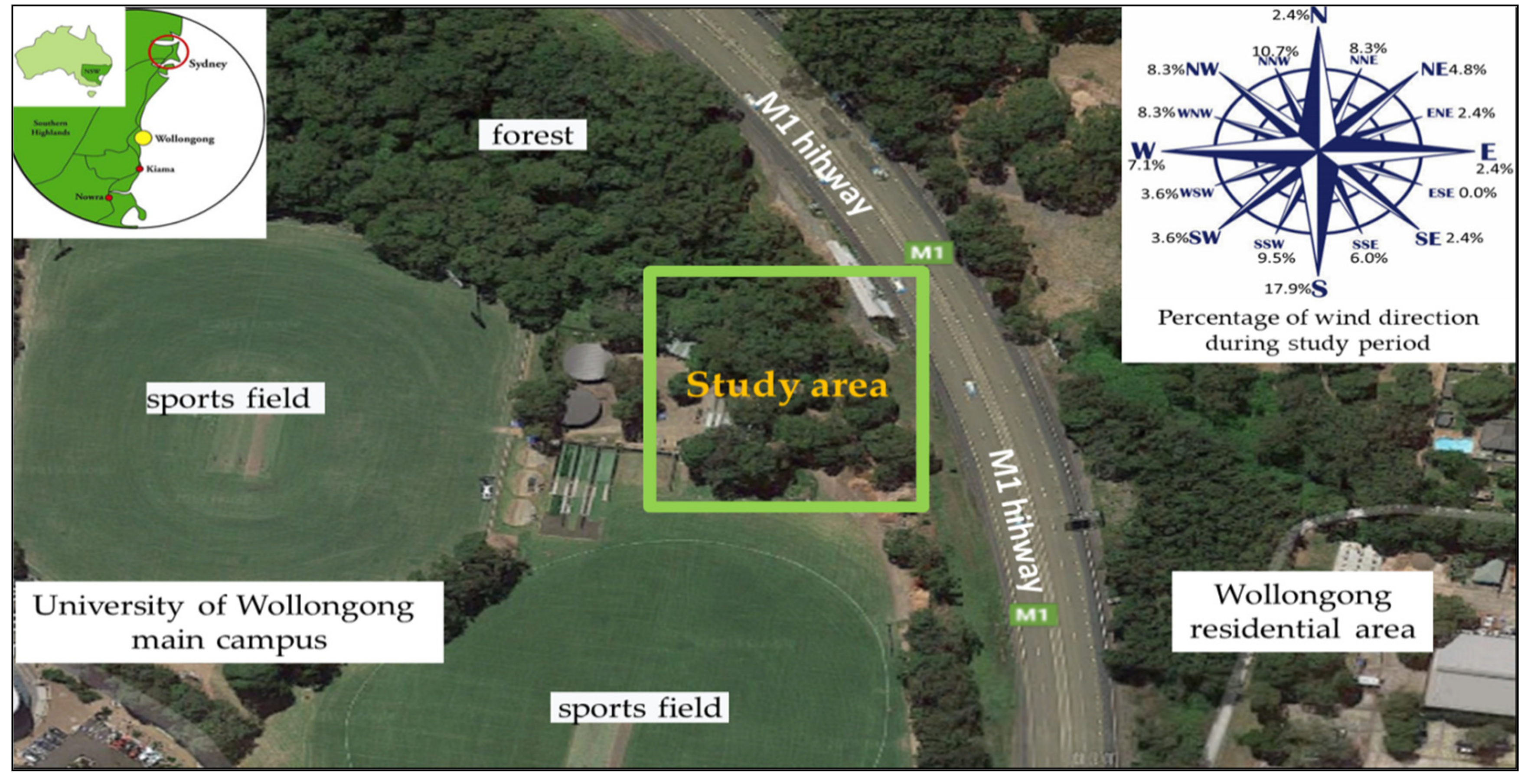

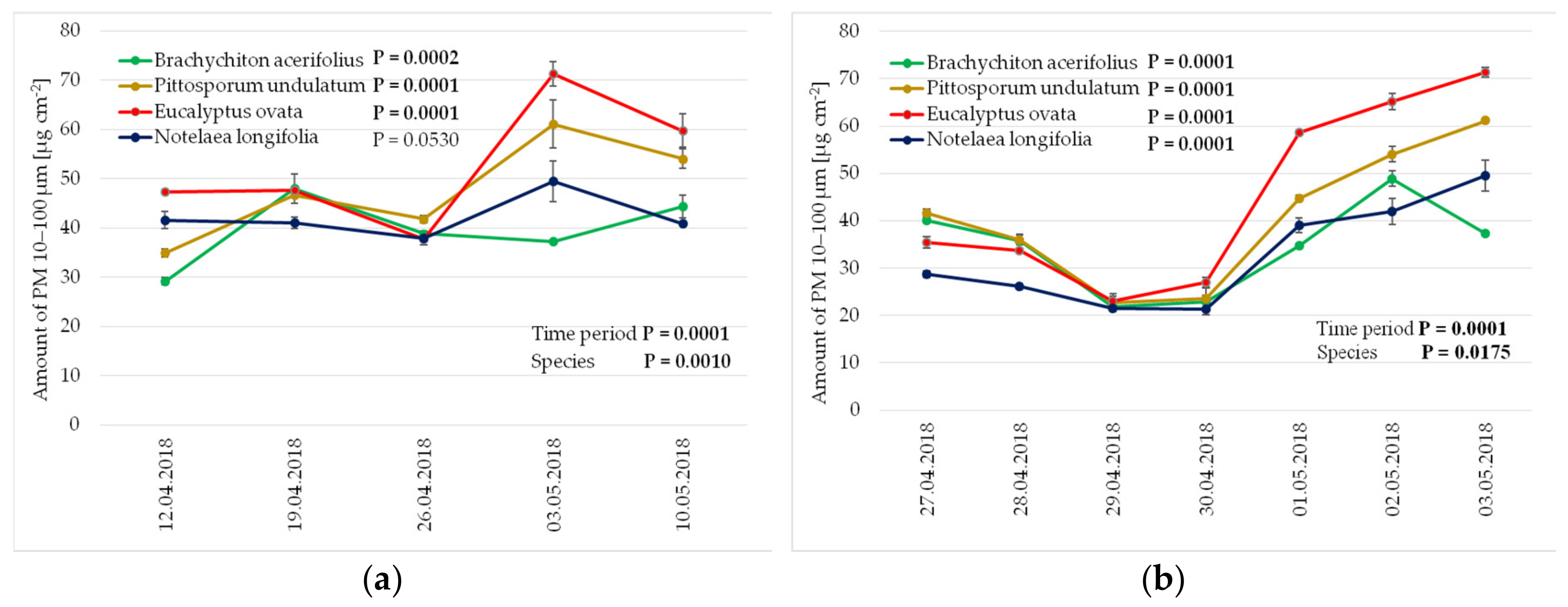
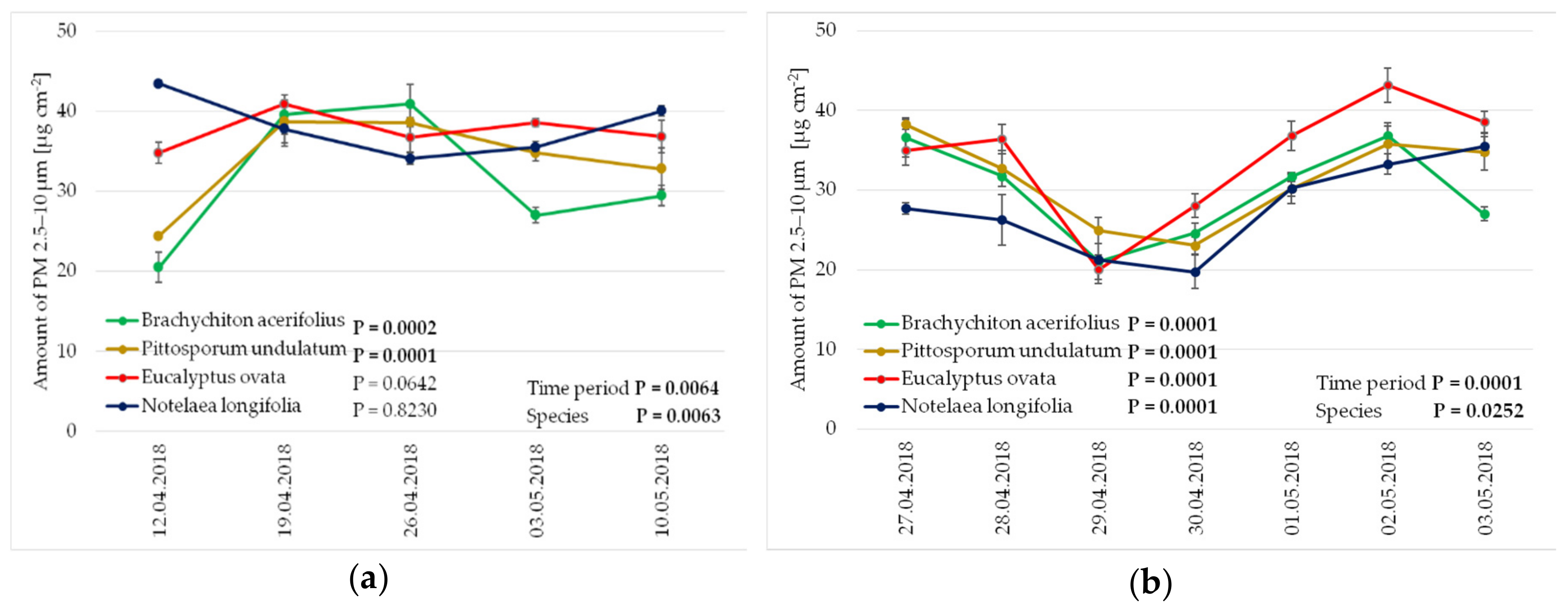

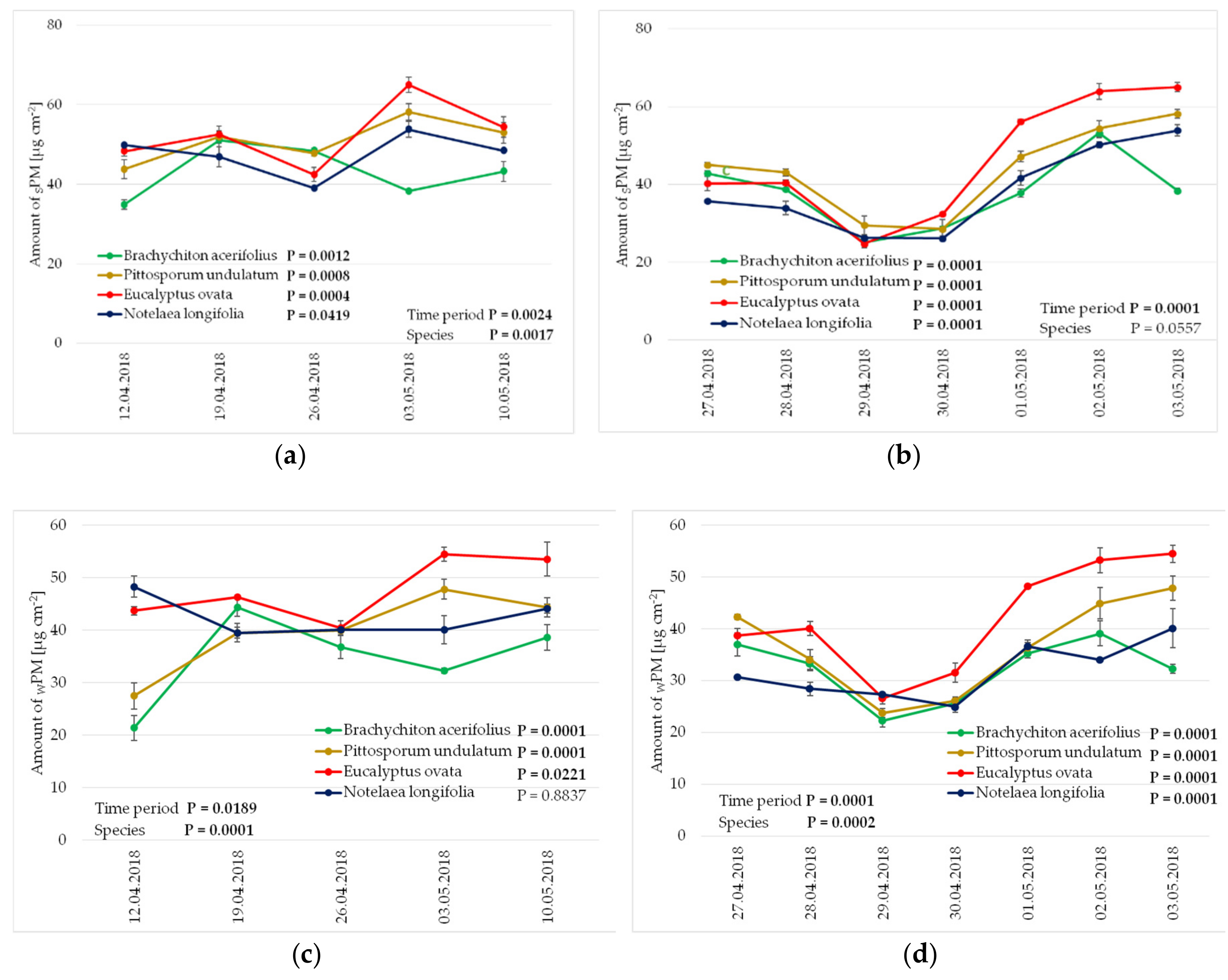
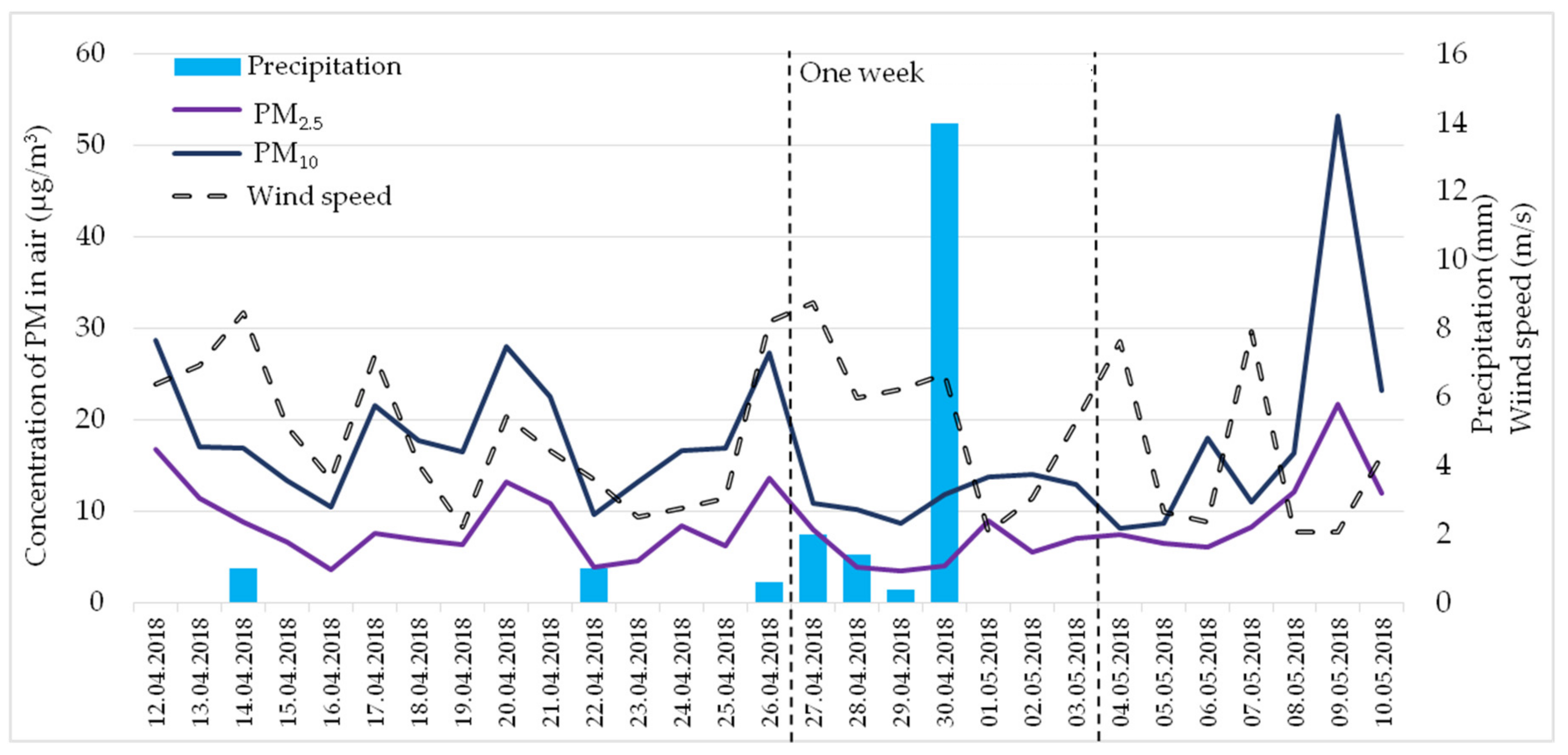
| Factor | Species | PM Fraction | Type of PM | |||
|---|---|---|---|---|---|---|
| PM 10–100 µm | PM 2.5–10 µm | PM 0.2–2.5 µm | SPM | WPM | ||
| Rainfall | Brachychiton acerifolius | −0.56 | −0.37 | −0.15 | −0.49 | −0.48 |
| Pittosporum undulatum | −0.58 | −0.60 | −0.03 | −0.65 | −0.54 | |
| Eucalyptus ovata | −0.48 | −0.40 | −0.21 | −0.46 | −0.50 | |
| Notelaea longifolia | −0.57 | −0.62 | −0.04 | −0.58 | −0.60 | |
| Wind speed | Brachychiton acerifolius | −0.33 | −0.18 | −0.16 | −0.35 | −0.31 |
| Pittosporum undulatum | −0.45 | −0.06 | −0.57 | −0.45 | −0.27 | |
| Eucalyptus ovata | −0.63 | −0.44 | −0.39 | −0.61 | −0.59 | |
| Notelaea longifolia | −0.59 | −0.47 | −0.14 | −0.53 | −0.52 | |
| PM10 in air | Brachychiton acerifolius | 0.60 | 0.52 | −0.25 | 0.63 | 0.65 |
| Pittosporum undulatum | 0.54 | 0.48 | 0.67 | 0.57 | 0.54 | |
| Eucalyptus ovata | 0.45 | 0.54 | 0.57 | 0.47 | 0.57 | |
| Notelaea longifolia | 0.63 | 0.81 | 0.22 | 0.57 | 0.85 | |
| PM2.5 in air | Brachychiton acerifolius | 0.57 | 0.46 | −0.12 | 0.51 | 0.65 |
| Pittosporum undulatum | 0.64 | 0.54 | 0.47 | 0.64 | 0.66 | |
| Eucalyptus ovata | 0.54 | 0.50 | 0.50 | 0.52 | 0.62 | |
| Notelaea longifolia | 0.65 | 0.76 | 0.25 | 0.59 | 0.84 | |
© 2019 by the authors. Licensee MDPI, Basel, Switzerland. This article is an open access article distributed under the terms and conditions of the Creative Commons Attribution (CC BY) license (http://creativecommons.org/licenses/by/4.0/).
Share and Cite
Popek, R.; Haynes, A.; Przybysz, A.; Robinson, S.A. How Much Does Weather Matter? Effects of Rain and Wind on PM Accumulation by Four Species of Australian Native Trees. Atmosphere 2019, 10, 633. https://doi.org/10.3390/atmos10100633
Popek R, Haynes A, Przybysz A, Robinson SA. How Much Does Weather Matter? Effects of Rain and Wind on PM Accumulation by Four Species of Australian Native Trees. Atmosphere. 2019; 10(10):633. https://doi.org/10.3390/atmos10100633
Chicago/Turabian StylePopek, Robert, Alison Haynes, Arkadiusz Przybysz, and Sharon A. Robinson. 2019. "How Much Does Weather Matter? Effects of Rain and Wind on PM Accumulation by Four Species of Australian Native Trees" Atmosphere 10, no. 10: 633. https://doi.org/10.3390/atmos10100633





